Society events during Spring 2004
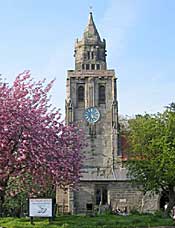 |
Keyworth church. |
Annual General Meeting, Keyworth – 24 April
Once again the Society managed to keep business to a minimum at the AGM – this year held in Keyworth, which boasts a very well appointed village hall – with the added bonus of a cricket match going on outside (this did tend to distract the attention of one or two of the attendees!)
In his remarks, our Chairman John Beckett thanked those who contributed to the life of the Society, pointing out the widening variety of activities and opportunities afforded members; and he also drew attention to the excellent volume of Transactions, now with many full colour illustrations. The business of the meeting included the election of Officers and the Council. This year we have two new recruits: Leslie Cram, who picks up the traces of programme management from Jean Nicholson, who has retired after many years of sterling work; and Alan Langton joins Council. We are pleased to welcome them both.
Following on from the business of the Annual General Meeting, Mr. Bob Hammond gave a brief but detailed history of the village of Keyworth, and acted as our guide when we visited the small parish church of Saint Mary Magdalene. A Society Annual General Meeting would not be complete without an excellent tea, and this one was no exception – a splendid feast laid on by the ladies of Keyworth W.I. The only slight hitch was the late arrival of the coach for return to Nottingham: anxious moments as the Chairman contemplated squeezing eighteen members into his car! But the coach did eventually arrive, rounding off an interesting afternoon. [Picture from left: Leslie Cram, President Neville Hoskins, Chairman John Beckett, Alan Langton].
Barbara Cast
75th Anniversary of ‘new’ Council House Opening
During the afternoon of 22 May 1929, in glorious weather, architect T. Cecil Howitt handed the golden key of the new Council House to the Prince of Wales (later King Edward VIII). The Prince then officially opened the Council House and Processional Way. No-one doubted the significance of the occasion, and the neo-baroque building was pronounced a major civic success. Three-quarters of a century later the Council House continues to be a main focus in the city, its classical features a timeless tribute to Howitt’s design of 1924.
On 20 May this year the new Lord Mayor of Nottingham, Cllr John Hartshorne, marked the 75th Anniversary of the official opening of the Council House with a civic reception in the principal reception hall, reputedly a replica of the ballroom in the Palace of Versailles. Invitees included members of the Civic Society and the Thoroton Society, key Nottingham figures, and elderly guests - some having been present at the Council House opening, and others having worked there.
The evening also saw the launch of The Council House and Old Market Square. After the Lord Mayor’s welcome, during which he spoke of the history of the Council House and of his hopes for its future, and speeches by Hilary Sylvester (chair of Nottingham Civic Society), John Beckett and Ken Brand, guests were entertained to a buffet reception. The Lord Mayor and Sheriff, Cllr Derek Cresswell, then cut the celebratory cake, and honorary aldermen gave guests a guided tour of the building.
Upper Palaeolithic Cave Art in Nottinghamshire: Conference Report
Art on cave walls of Upper Palaeolithic people – homo sapiens just like ourselves – has been found for the first time in Britain, and it comes from Church Hole at Creswell Crags in Nottinghamshire. The art was recognized in 2003 by two British archaeologists, and one, with the ‘eye’, from Spain. It is in the form of engravings high above the present floor level and tucked away at the back of the cave – an ibex or deer, a wild ox, birds and strange symbolic forms. It is immediately recognizable in the style so well known in the caves in France and Spain. The colder and damper British climate has probably removed paintings and covered over many engravings with dripstone in our caves.
An international conference ‘Creswell Art in European Context’ was
run by the Creswell Crags Museum & Education Centre and the University
of Sheffield in Creswell village from 15-17 April, bringing speakers from
English Heritage, the British Museum, and universities in England and across
Europe. Access for the general public to see the engravings is a
challenge yet to be resolved, but the images and details can be seen on
the internet (see sites below) – and one of the discoverers of the
art will tell us the story at our lecture in January 2005. Leslie
Cram http://www.creswell-crags.org.uk/CHT/News_and_views/index.html; http://www.shef.ac.uk/archaeology/conf/creswell/cresswell.htm
http://www.shef.ac.uk/~capra/5/pettitt.html
REPORT OF LECTURES AND EXCURSIONS
Friday 5 March – Launch of the Newcastle Diaries
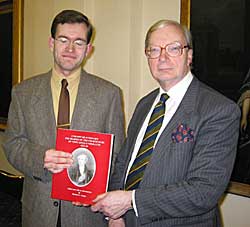 |
Nearly ninety people gathered in the University of Nottingham’s Senate Chamber for the launch of the most recent publication in Thoroton Record Society’s series, Dr Richard Gaunt’s edition: Unhappy Reactionary: the Diaries of the Fourth Duke of Newcastle-under-Lyne, 1822-50. The event was jointly hosted by the Thoroton Society and the School of History at Nottingham University.
Lynda Crawford spoke about the Newcastle collection and recent cataloguing work, Richard Gaunt talked about the work he had undertaken in editing the diaries for publication, and Dorothy Johnston discussed the Newcastle family portraits now housed in the Senate Chamber, as well as the 4th Duke’s attitude towards having his portrait painted.
The book was officially launched by Clive Priestley, whose own study of the 2nd Duke of Newcastle was completed in 1958. Clive, who was one of the first researchers to work on the Newcastle papers after they were deposited in the 1950s, went on to a successful career in the Civil Service, but still retains an interest in his alma mater. Alan Langton was among those attending who were able to reminisce with Clive about the function in their student days of what is today the Senate Chamber. This was a splendid evening! John Beckett
Saturday 13 March – The Park and Gardens at Clumber
 |
Neil Porteus. |
Neil Porteus, Head Gardener at Clumber Park, delighted a large gathering of members and friends to a talk about the park and gardens at Clumber. Using old maps and the many plans drawn by John Simpson in the 1780s for the 2nd Duke of Newcastle, Neil showed the elaborate arrangement of alleys and rides and the varieties of trees used – many of these still exist today. We marvelled not only at the vision of these men who planted for the future with no hope of seeing their schemes mature, but also at the vast sums of money spent and the number of men employed to keep the gardens in good order. Today only three gardeners, including Neil (pictured left) are employed full-time.
Old photographs transported us back to the age of elegance, when the terraces between the house and lake were ablaze with colour and the gravelled walks lined with statues collected by the Newcastles on their Grand Tours. Until recently it was thought that all trace of the alcoves and statues had disappeared, but Neil has found some buried in the undergrowth. Within the next few years he hopes to have some of the walks restored and the statues back in place. Neil ended his talk with an outline of his plans for the continued restoration of the kitchen garden, which already provides seasonal fruit and vegetables for the Clumber restaurant, and for ‘taster days’ when old varieties can be tried and compare with the often tasteless supermarket varieties. Jean Nicholson
Saturday 8 May – Excursion to Roche Abbey, Conisbrough Castle and Brodsworth Hall
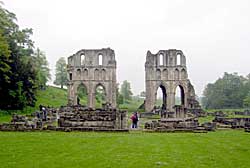 |
Roche Abbey. |
The first excursion of the season took us to three English Heritage sites in South Yorkshire. Squeezing down a green and narrow lane, we saw in a grassy clearing the ruins of Roche Abbey (pictured left), which was founded by Cistercian monks in 1147. The setting was landscaped in the eighteenth century by Capability Brown. We then travelled on to Conisbrough Castle (pictured below), whose 90-ft high buttressed keep, which was built around 1185, is the oldest surviving circular keep in England, with fine views from the top. Afterwards lunch was taken in the grounds of the Castle, and some Society members visited St Peter's church to look at Saxon work on arcades and monuments.
The afternoon was spent at Brodsworth Hall, a Victorian country house designed in the Italian style and built in the 1860s. Here we saw the ‘Maids and Mistresses’ exhibition, depicting the lives of women who lived or worked there. After viewing the faded grandeur of the Hall we strolled in the restored garden and worked up an appetite for a scrumptious tea in true Thorotonian tradition. Grateful thanks go to Bob Creates for leading a very interesting and full day, and to Peter Reddish for his assistance with the research. Glenice Pringle
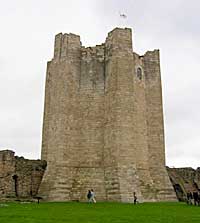 |
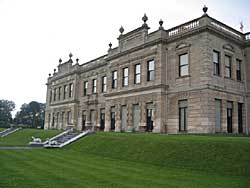 |
Conisbrough Castle. |
Brodsworth Hall. |